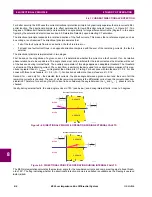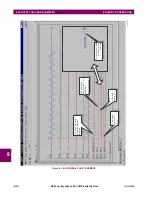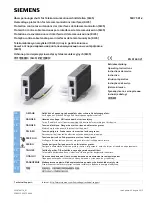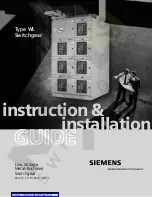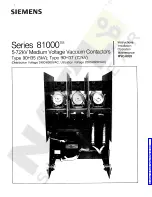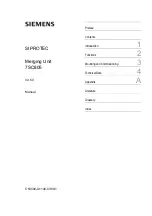
GE Multilin
B90 Low Impedance Bus Differential System
9-7
9 APPLICATION OF SETTINGS
9.4 SLOPES AND HIGH SET THRESHOLD
9
9.4.3 EXTERNAL FAULTS ON C-2
The following table presents the results of analysis of an external fault on circuit C-2 (C-2 is connected to the North bus; C-
3, C-4 and C-5 are connected to the South bus).
By comparing the secondary currents (column 3 in the following table) with the limits of linear operation for the CTs (column
4 shown earlier in the Limits of Linear Operations of the CTs table) it is concluded that CT-2 will saturate during this fault
producing a spurious differential signal. All other CTs will not saturate due to the AC components. The amount of the spuri-
ous differential current (magnetizing current of CT-2) can be calculated using the burden, magnetizing characteristic and
the primary current of the said CT.
For
I
s
= 116.67 A,
R
s
= 1.23
and the characteristic shown earlier in the Approximate CT Magnetizing Characteristics fig-
ure, the solution is
I
magnetizing
= 27.69 A,
I
relay
= 113.3 A.
The magnetizing current of the saturated CT-2 will appear to the differential element protecting the North bus as a differen-
tial signal of 27.69 A, while the restraint signal will be the maximum of the bus currents (113.3 A). Consequently, the higher
slope of the characteristic should not be lower than 27.69 A / 113.3 A, or 24% and the pick up of the high-set differential
elements should not be lower than 27.69 A, or 2.77 pu.
Columns 6 and 7 of the following table summarize the DC saturation threat for the fault on C-2. CT-4, CT-6, CT-7, and CT-
8 may saturate due to the DC components and may generate spurious differential signal for both the North and South bus
relays depending on the bus configuration. The saturation will not occur before 4.7 ms and will be detected by the Satura-
tion Detector.
9.4.4 EXTERNAL FAULTS ON C-3
The following table presents the results of analysis of an external fault on circuit C-3 (C-3 is connected to the North bus; C-
4 and C-5 are connected to the South bus).
By comparing the secondary currents (column 3 in the table below) with the limits of linear operation for the CTs (column 4
in the Limits of Linear Operations of the CTs table shown earlier), it is concluded that none of the CTs will saturate due to
the AC currents during this fault.
Columns 6 and 7 of the table below summarize the DC saturation threat for the fault on C-3. CT-3, CT-4, CT-6, CT-7, and
CT-8 may saturate due to the DC components and may generate a spurious differential signal for both the North and South
bus relays depending on the bus configuration. The saturation will not occur before 11.18 ms and will be detected by the
Saturation Detector.
Table 9–5: EXTERNAL FAULT CALCULATIONS ON C-2
CT
I
FAULT
(KA)
I
FAULT
(A SEC)
T
DC
(MS)
AC
SATURATION
DC
SATURATION
T
SAT
(MS)
CT-1
0
0.00
N/A
No
No
N/A
CT-2
14.0
116.67
40
Yes
Yes
N/A
CT-3
6.0
25.00
5
No
No
N/A
CT-4
5.0
25.00
30
No
Yes
15.19
CT-6
3.0
15.00
40
No
Yes
35.25
CT-7, CT-8
14.0
58.33
40
No
Yes
4.70
Table 9–6: CALCULATIONS FOR THE EXTERNAL FAULTS ON C-3
CT
I
FAULT
(KA)
I
FAULT
(A SEC)
T
DC
(MS)
AC
SATURATION
DC
SATURATION
T
SAT
(MS)
CT-1
0
0.00
N/A
No
No
N/A
CT-2
0
0.00
N/A
No
No
N/A
CT-3
8.0
33.33
40
No
Yes
11.18
CT-4
5.0
25.00
30
No
Yes
15.19
CT-6
3.0
15.00
40
No
Yes
35.25
CT-7, CT-8
8.0
33.33
40
No
Yes
11.18
Summary of Contents for B90
Page 10: ...x B90 Low Impedance Bus Differential System GE Multilin TABLE OF CONTENTS ...
Page 284: ...5 166 B90 Low Impedance Bus Differential System GE Multilin 5 8 TESTING 5 SETTINGS 5 ...
Page 334: ...10 8 B90 Low Impedance Bus Differential System GE Multilin 10 2 BATTERIES 10 MAINTENANCE 10 ...
Page 338: ...A 4 B90 Low Impedance Bus Differential System GE Multilin A 1 PARAMETER LISTS APPENDIX A A ...
Page 460: ...C 30 B90 Low Impedance Bus Differential System GE Multilin C 7 LOGICAL NODES APPENDIX C C ...
Page 476: ...E 10 B90 Low Impedance Bus Differential System GE Multilin E 1 IEC 60870 5 104 APPENDIX E E ...
Page 502: ...viii B90 Low Impedance Bus Differential System GE Multilin INDEX ...




